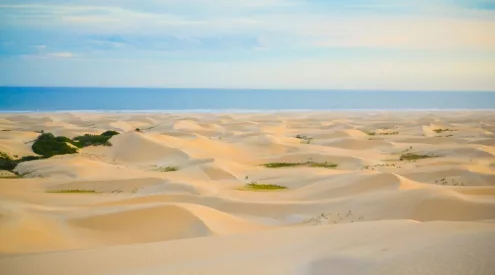Participate in International Coastal Cleanup Day this Saturday, 15 September 2018 and help clean our polluted coastline while providing insights on culprit waste materials.

A curious juvenile batfish following us around in the water off Chumbe Island. Photo by Teagan Cunniffe.
The trash that’s increasingly found in the ocean poses a great danger to our seas and marine species as most of the animals mistake it for food while others are entangled by it with lethal consequences. Plastic being the major pollutant attracts and concentrates other pollutants from surrounding seawater, posing a contamination risk to those species.
“While the beauty of our coastlines attracts people from far and wide, the high volumes of waste produced poses a major threat to our precious coastal environments,” says Leon Grobbelaar, president of the Institute of Waste Management of Southern Africa (IWMSA). Solutions to marine pollution are necessary to protecting the endangered species that inhabit coastal marine environments, he notes. International Coastal Cleanup Day is an initiative aimed at cleaning up the ocean while also conducting research on the culprit waste materials.
The Ocean Conservancy collected data from the combined global cleanup in 2017 and revealed that 789 thousand people collected 9285 tonnes of waste over 30472 Kilometres of the coastline.
In South Africa, the 2017 coastal cleanup saw 16298 people participating in the clean-up, picking up a total of 12694 Kilograms of waste. Of the 16298 volunteers, 4755 recorded what they picked up, providing data that helps with highlight culprit waste materials that are prominent in coastal environments.
So far, the data indicates that food wrappers, especially chip packets, made from multi-layered plastics have been increasing in numbers on a yearly basis. The food wrappers were the fourth highest item collected in 2016 and were the prolific collected item in 2018. Other items include asthma pumps, single-use baby diapers and disposable syringes which were also recorded in larger numbers in the 2017 cleanup.
Grobbelaar said that some of the trash flies into the ocean from open bins on the coast. “Bin lids need to be closed at all times. When lids are open, the contents of the bin will be subjected to the wind which will lift and carry waste items, especially lightweight plastics, into the sea,” he adds. “This is the reason why items such as straws, food wrappers and plastic bags become prevalent on beaches.”
“Find your closest local cleanup taking place on International Coastal Cleanup Day and encourage all your friends and family to participate with you,” said Grobbelaar. “Ask the cleanup organiser for a waste data sheet to record what you pick up. This will contribute to the valuable data for the Ocean Conservancy’s 2018 cleanup report,” concludes Grobbelaar.
Read more about International Coastal Cleanup taking place this Saturday 15 September 2018 and find your nearest Cleanup location using this map.
Make sure to download this awesome application
Download the Clean Swell app onto your phone before the cleanup and become a citizen scientist while you collect trash. This app will let you share your achievements, and also provide valuable data to the Ocean Conservancy‘s research database because it helps to record every item of trash you collect, track your total distance cleaned and helps to identify trash trends. Download it for Apple or Android.















